CONTENT OF BIOLOGICALLY ACTIVE SUBSTANCES IN THE ABOVEGROUND PART OF SOME ONION SPE-CIES (ALLIUM L.)
Abstract
The results of comparative study of the content of biologically active substances in the aboveground part of 11 species of perennial onions Allium aflatunense B. Fedtsch., A. altaicum Pall., A. flavum L., A. microdictyon Prokh., A. nutans L., A obliquum L., A. ramosum L., A. rosenbachianum Regel, A. schoenoprasum L., A. senescens L. var. glaucum Regel (A. senescens ssp. glaucum (Schrad.) N. Friesen), A. strictum Schrad. are presented. The freshly collected raw materials in the phase of consumer ripeness were analyzed and all indicators, except for the amount of ascorbic acid, were calculated on the mass of absolutely dry raw materials. It was established in onions a high content of dry substances (up to 25.1%), flavonols (up to 3.4%), tannins (up to 14.6%), pectin substances (up to 25.8%), sugars (up to 34.8%), ascorbic acid (up to 222.5 mg% ), carotenoids (up to 131.9 mg%); the content of catechins was insignificant, at the level of 0.04–0.15%, only in A. rosenbachianum – up to 0.56%. The contents of catechins, tannins, pectin substances in onions were determined for the first time. A high interspecific and individual variability of accumulation of biologically active substances was revealed. A. rosenbachianum, A. aflatunense, A. flavum, A. microdictyon have the greatest contents and relatively low indicators are in A. senescens var. glaucum. The species are promising for cultivation in the forest-steppe zone of Western Siberia as early vitamin-bearing plants and as a source of various biologically active compounds.
Downloads
Metrics
References
Seregin A.P., Anaćkov G., Friesen N. Botanical Journal of the Linnean Society, 2015, vol. 178, no. 1, pp. 67–101. DOI: 10.1111/boj.12269.
Kazakova A.A., Gritsenko P.P., Borisenkova L.S. Trudy po prikladnoy botanike i selektsii, 1982, vol. 72, no. 3, pp. 13–22. (in Russ.).
Ludilov V.A., Ivanova M.I. Redkiye i malorasprostranennyye ovoshchnyye kul'tury (biologiya, vyrashchivaniye, se-menovodstvo). [Rare and rare vegetables (biology, cultivation, seed production)]. Moscow, 2009, 195 p. (in Russ.).
Perezhogina V.V. i dr. Izucheniye i podderzhaniye v zhivom vide mirovoy kollektsii luka i chesnoka: (metodicheskiye ukazaniya). [Studying and keeping alive the world collection of onions and garlic: (guidelines)]. St. Petersburg, 2005, 109 p. (in Russ.).
Kazakova A.A. Kul'turnaya flora SSSR. [The cultural flora of the USSR]. Leningrad, 1978, vol. 10, 264 p. (in Russ.).
Cheremushkina V.A., Dneprovskiy Yu.M., Grankina V.P., Sudobina V.P. Kornevishchnyye luki Severnoy Azii: Bi-ologiya, ekologiya, introduktsiya. [Rhizome bows of North Asia: Biology, ecology, introduction]. Novosibirsk, 1992, 159 p. (in Russ.).
Rastitel'nyye resursy Rossii i sopredel'nykh gosudarstv: Tsvetkovyye rasteniya, ikh khimicheskiy sostav, ispol'zovaniye; Semeystva Butomaceae – Typhaceae. [Plant resources of Russia and neighboring countries: Flowering plants, their chemical composition, use; Families Butomaceae – Typhaceae]. St. Petersburg, 1994, 271 p. (in Russ.).
Keusgen M., Fritsch R.M., Hisoriev H., Kurbonova P.A., Khassanov F.O. J. of Ethnobiology and Ethnomedicine, 2006, vol. 2, article 18, DOI:10.1186/1746-4269-2-18.
Verner A.R., Delova G.V. Rastitel'nyye resursy Sibiri, Urala i Dal'nego Vostoka. [Plant Resources of Siberia, the Urals and the Far East]. Novosibirsk, 1965, pp. 114–125. (in Russ.).
Kyung K.H. Current Opinion in Biotechnology, 2012, vol. 23, no. 2, pp. 142–147, DOI: 10.1016/j.copbio.2011.08.004.
Rastitel'nyye resursy Rossii: Dikorastushchiye tsvetkovyye rasteniya, ikh komponentnyy sostav i biologicheskaya ak-tivnost'. T. 6. Semeystva Butomaceae – Typhaceae [Plant resources of Russia: Wild flowering plants, their component composition and biological activity. Vol. 6. Families Butomaceae – Typhaceae], ed. A.L. Budantsev, St. Petersburg; Moscow, 2014, 391 p. (in Russ.).
Lanzotti V. Phytochemistry Reviews, 2005, no. 4, pp. 95–110, DOI: 10.1007/s11101-005-1254-1.
Štajner D., Milić N., Čanadanović-Brunet J., Kapor A., Štajner M., Popović B.M. Phytotherapy Research, 2006, vol. 20, pp. 581–584, DOI: 10.1002/ptr.1917.
Štajner D., Popović B.M. Central European Journal of Biology, 2009, no. 4 (2), pp. 224–228, DOI: 10.2478/s11535-009-0010-8.
Benkeblia N. Bioscience, 2007, vol. 1, no. 3, pp. 135–140.
Golubkina N.A., Sirota S.M., Pivovarov V.F., Yashin A.Ya., Yashin Ya.I. Biologicheski aktivnyye soyedineniya ovoshchey. [Biologically active compounds of vegetables]. Moscow, 2010, 200 p. (in Russ.).
Cerella C., Kelkel M., Viry E., Dicato M., Jacob C., Diederich V. Phytochemicals – Bioactivities and Impact on Health, ed. I. Rasooli, Croatia: IntechOpen, 2011, pp. 3–42, DOI: 10.5772/26003.
Delova G.V. Introduktsiya rasteniy i zelenoye stroitel'stvo. Trudy BIN im. V.L. Komarova. [Plant Introduction and Green Building. Proceedings of BIN named after V.L. Komarova]. St. Petersburg, 1959, series VI, vol. 7, pp. 138–141. (in Russ.).
Kazakova A.A., Mishchik S.K. Trudy po prikladnoy botanike i selektsii, 1974, vol. 51, no. 3, pp. 77–88. (in Russ.).
Golubev F.V., Gorbunov Yu.N., Safronova L.M. Byulleten' Glavnogo botanicheskogo sada, 2003, no. 185, pp. 184–188. (in Russ.).
Agafonov A.F., Dudchenko N.S., Golubkina N.A. Ovoshchi Rossii, 2009, no. 1, pp. 25–30. (in Russ.).
Shirshova T.I., Beshley I.V., Matistov N.V. Vestnik Instituta biologii Komi NTS UrO RAN, 2011, no. 10–11, pp. 15–21. (in Russ.).
Kukushkina T.A., Zykov A.A., Obukhova L.A. Aktual'nyye problemy sozdaniya novykh lekarstvennykh preparatov prirodnogo proiskhozhdeniya: Materialy VII Mezhdunarodnogo s"yezda. [Actual problems of creating new drugs of natural origin: Materials of the VII International Congress]. St. Petersburg, 2003, pp. 64–69. (in Russ.).
Belikov V.V., Shrayber M.S. Farmatsiya, 1970, no. 1, pp. 66–72. (in Russ.).
Fedoseyeva L.M. Khimiya rastitel'nogo syr'ya, 2005, no. 2, pp. 45–50. (in Russ.).
Kriventsov V.I. Sbornik nauchnykh trudov Gosudarstvennogo Nikitskogo botanicheskogo sada, 1989, vol. 109, pp. 128–137. (in Russ.).
Metody biokhimicheskogo issledovaniya rasteniy [Methods of biochemical research of plants], ed. A.I. Yermakov. Len-ingrad, 1987, 420 p. (in Russ.).
Tselishcheva E.P. Novyye pishchevyye rasteniya dlya Sibiri (plodovyye, yagodnyye, ovoshchnyye, zernovyye). [New food plants for Siberia (fruit, berry, vegetable, grain)]. Novosibirsk, 1978, pp. 118–129. (in Russ.).
Tukhvatullina L.A. Vestnik Orenburgskogo gosudarstvennogo universiteta, 2010, no. 6 (112), pp. 160–162. (in Russ.).
Tukhvatullina L.A., Abramova L.M. Cel'skokhozyaystvennaya biologiya, 2012, no. 3, pp. 109–113. (in Russ.).
Ishankulova B.A., Khalilova Sh.N. Vestnik Avitsenny, 2017, vol. 19, no. 1, pp. 109–112, DOI: 10.25005/2074-0581-2017-19-1-109-112 (in Russ.).

Copyright (c) 2019 Khimiia rastitel'nogo syr'ia (Chemistry of plant raw material)

This work is licensed under a Creative Commons Attribution 4.0 International License.

This work is licensed under a Creative Commons Attribution 4.0 International License.
The authors, which are published in this journal, agree to the following conditions:
1. Authors retain the copyright to the work and transfer to the journal the right of the first publication along with the work, at the same time licensing it under the terms of the Creative Commons Attribution License, which allows others to distribute this work with the obligatory indication of the authorship of this work and a link to the original publication in this journal .
2. The authors retain the right to enter into separate, additional contractual agreements for the non-exclusive distribution of the version of the work published by this journal (for example, to place it in the university depository or to publish it in a book), with reference to the original publication in this journal.
3. Authors are allowed to post their work on the Internet (for example, in a university repository or on their personal website) before and during the review process of this journal, as this may lead to a productive discussion, as well as more links to this published work.











